Nee Soon Garrison - our new home
Singapura, I've arrived! Experiences of a British Teenager in a Tropical Paradise (ch 2)
You’re on the free list—thank you! To support my work, receive my personal recipes as well as the opportunity to connect one on one, please consider becoming a paid subscriber for $30 per year or $5 per month.
OMG, where do I even start? I have so many amazing memories, but I don't want to bore you. You know how it is, everyone's experience was totally different depending on their family, where they lived on the island, and whether they were a guy or a girl.
Let me tell you, the guys had some crazy stories that made us girls totally jelly, but when your dad, like mine was in the Royal Marines, you knew not to mess around...most of the time anyway. My dad used to say, "I'll give you enough rope, but it's up to you if you hang yourself."
If you were brave enough to push the boundaries without getting caught, you were basically a legend. I have to admit, I wasn't that brave, but I still had the time of my life! Looking back now, I realize how lucky we were to live in such a lush and tropical paradise.
Singapore in the 1960s was a busy and colourful place. The Rochor canal was a smelly, well, stinking waterway that connected different parts of the city. Along its banks, people lived and worked in shophouses, markets, temples, and mosques. The air was filled with many smells: sweet and spicy from the food stalls selling Malay, Chinese, and Indian dishes; smoky and oily from the factories and workshops; floral and fragrant from the flowers and incense offered at religious places; fishy and salty from the boats and barges carrying goods on the water; dusty and earthy from the construction sites and roads. The smells of old Singapore were a mix of cultures, traditions, and progress.
Singapore has a long and rich history that dates back to ancient times. It was once a part of various kingdoms and empires, such as Srivijaya, Singapura, Malacca, Johor, and the British Empire. It was also a thriving port city that attracted traders and travelers from all over Asia and Europe. Singapore witnessed many changes and challenges throughout its history, such as wars, invasions, colonialism, independence, merger with Malaysia, separation from Malaysia, and rapid modernization. Through it all, Singapore has maintained its multicultural identity and spirit of resilience. Today, Singapore is a prosperous and diverse nation that celebrates its past while looking forward to the future.
For a bit of home we shopped at Cold Storage in Orchard Road, Fitzpatricks and Robinsons. Cold Storage was the first supermarket in Singapore, established in 1903 selling frozen food, dairy products, ice-cream, bread and vegetables imported from various countries. The only place we could buy fresh milk. It also had an ice-cream parlour and a coffee lounge that were popular among European families especially the coke spiders.
Now, let me give you a little taste of what life was like in Nee Soon Garrison.
The centre of the garrison was The Loop. You could walk left to the pool and cricket grounds or right past all the army facilities, the cinema, to home. Here they filmed parts of movie, The Virgin Soldiers.
There were always soldiers marching or hiding in bushes practicing jungle warfare. To watch the squaddies practice drills was amazing, such precision that comes with practice and discipline.
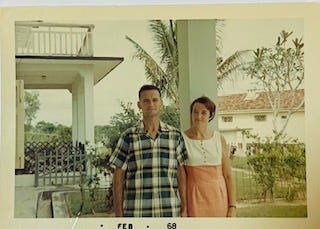
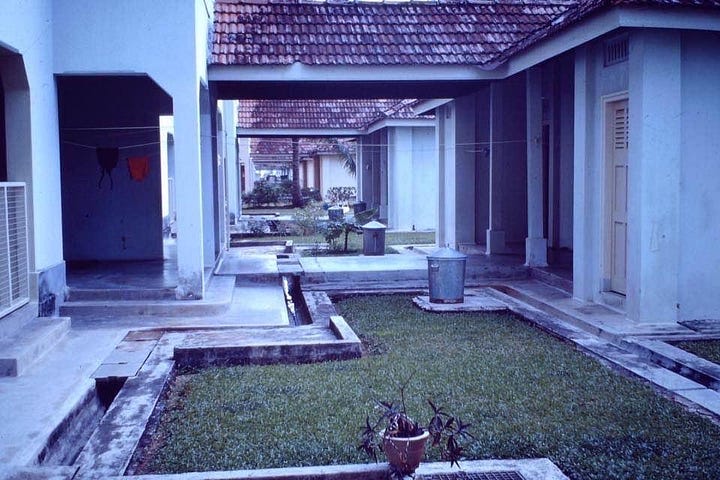
Home was two story house with the amah quarters out the back. Some families employed an amah do everything. Not so in our family. Mum and I did the cooking and we had to make our own beds. Our first amah Li had 6 children and our last was Moya, very young who was not much older than me. The one in the middle lasted only one day after she started throwing buckets of water around to wash the floors! Mum was horrified, I thought it funny.
We also had a gardener. To me he looked so old with bowed legs, but his ability to cut the lawns with a scythe was mesmerising. No lawn mowers in those days.
Our houses were cooled with ceiling fans and our windows had shutters for when it rained otherwise windows and doors were open all the time.
Ants were a problem, they were red, big and bit like crazy. Just ask my brother who had the misfortune to fall into a bush. He was in agony.
We spent all our spare time at the pool, it was the hub of socialising for families and the army guys.
Then there was the Friday night youth club. My next door neighbours The Browns kept to themselves, Karen was my age. Across the road were the Raymonds, Rhonda, my age, Rodney, Alan and two younger sisters. Below were the Maguire sisters, Bernadette, Barbara and Margaret.
We regularly socialised with the Dobson family from RAF Tengah, Pete was at St. Johns with me. Our parents went to many a mess function, dressed up as we did then.
For school I went to St Johns, Roger to Bourne and Michael to the Naval juniors up at the Naval Base. School transport were buses, old buses or jeeps if I stayed for after school activities.
Jane and I had much in common, especially dressmaking. We would buy material on a Friday and have a new dress for the dockyard dance on the Saturday. We shared a few classes, Music, English (dreamboat teacher ) and RI ( Mr Sayers who wore short socks with his sandals). We shared many weekends at each others houses, Jane on the Chip Bee Estate and me in Nee Soon. How much dare I reveal?
Riding in our school buses home from school between Dover Road and Nee Soon was an adventure during the monsoon season, bit like riding in a water park on wheels! From November to January sometimes, the rain is so heavy that the monsoon drains got full and water came up through the floorboards of the bus. That didn’t stop us from having fun! We enjoyed feeling the breeze through the open windows, no air conditioning needed. We watch the rain race down the monsoon drains and listened to the sound of thunder and see flashes of lightning in the sky.
When we got off the bus we would take off our shoes, feeling the warm water on our feet as we splashed in the puddles laughing. Jumping puddles isn’t only for little children
Walking in the rain in Singapore with no shoes was like having a spa treatment for our feet!
Nee Soon, was one of the oldest Chinese kampongs in Singapore, named after rubber magnate Lim Nee Soon. Located in the northern part of the island, surrounded by rubber plantations and pineapple farms, life in Nee Soon was simple and rustic, with most residents living in wooden houses on stilts. They shared communal facilities such as wells, toilets and kitchens. They also practiced gotong royong, a spirit of mutual help and cooperation. The kampong dwellers engaged in various occupations such as fishing, farming, rubber tapping and fruit selling.
There was a variety of fruits that grew abundantly in the area, such as coconuts, bananas, papayas, pineapples and rambutans. Some of them also sold their fruits at nearby markets or along the roadsides. Nee Soon was a multicultural kampong that had Chinese, Malay and Indian residents. They celebrated different festivals and shared their food culture with each other. There were always chickens, dogs and cats wandering and childfren being washed under the roadside taps.
Next to the rubber plantations were biscuit factories, such as Thye Hong, which produced biscuits such as Marie Cream Crackers, Horlicks biscuits and Jam De Luxe cookie,employing more than 200 workers. Another well-known biscuit maker was Khong Guan, producing 10,000 tins of biscuits daily and became famous for its cream crackers and lemon puff biscuits. We bought biscuits in large tins, one of our favourites was little iced gems. They are still made today and can be bought around the world.
Grocery shop houses were a common sight in Singapore in the 1960s, especially in rural areas like Nee Soon. They served as both a home and a place of business for the owners and their families. The shop houses were usually one or two storeys tall, with a five-foot way that provided shelter for pedestrians and customers. The ground floor was used for selling groceries and other daily necessities, while the upper floors or a room out the back were used for living quarters. The shop houses reflected the diverse architectural styles and influences of Singapore’s multicultural society, ranging from poorly constructed timber hovels to Chinese to Peranakan to Art Deco. Some of them also had decorative features such as pintu pagar (half-height outer doors), ceramic tiles and plaster mouldings. Grocery shop houses were an important part of Singapore’s social and economic life until they were gradually replaced by modern supermarkets and high-rise residential buildings in later years.
In Nee Soon we attended many festivals each year:
Chinese New Year: This was the most important festival for the Chinese residents of Nee Soon, who made up the majority of the population. They celebrated by decorating their houses with red lanterns and couplets, exchanging red packets and enjoying festive delicacies such as pineapple tarts, bak kwa (barbecued pork) and yusheng (raw fish salad).
Pongal: This was a harvest festival celebrated by the Indian residents of Nee Soon, especially those from Tamil Nadu. It was held in mid-January and lasted for four days. The festival involved cooking rice with milk in clay pots over open fires, offering prayers to the sun god Surya and various farm animals, wearing new clothes and sharing sweet dishes such as pongal (rice pudding) and payasam (milk pudding).
Hari Raya Puasa: This was a festival celebrated by the Malay residents of Nee Soon, marking the end of Ramadan, the Islamic month of fasting. It was held on the first day of Syawal, which usually falls in May or June. The festival involved attending prayers at mosques, visiting graves of loved ones, seeking forgiveness from elders and relatives, wearing new clothes and feasting on traditional dishes such as ketupat (rice cakes), rendang (spicy meat stew) and kueh (cakes).
Mid-Autumn Festival: This was another festival celebrated by the Chinese residents of Nee Soon, occurring on the 15th day of the eighth lunar month, which usually falls in September or October. The festival commemorated a legendary uprising against Mongol rule in China during the Yuan dynasty. The festival involved admiring the full moon at night, carrying lanterns of various shapes and sizes, solving riddles written on lanterns and eating mooncakes (pastries filled with lotus seed paste or other fillings)
“I eat therefore I am” is the creed by which Singaporeans live. Singapore’s food has as mixed heritage as its people, a fact that comes to life at the country’s crowded hawker centres. A walk in Singapore among the street food stalls was a sensory adventure that tantalized the taste buds and awaken ones curiosity. Here’s how I would describe it:
As you strolled along the bustling streets, you are greeted by a symphony of sizzling, frying, and chopping sounds from the various hawker stalls. The air was filled with enticing aromas of spices, sauces, and meats that make your mouth water. You see colorful displays of dishes from different cuisines, such as Chinese, Indian, Malay, and Peranakan. Mouth watering satay sticks were the favourite, made your taste buds sing. The skewers of juicy meat were grilled over open charcoal fire (no food regs in those days) and slathered with a rich peanut sauce that is sweet, spicy and tangy. Whether you prefer chicken, beef, mutton or even fish, there is a satay stick for everyone.
During the monsoon season, the rain was torrential, flooding the monsoon drains & roads.
Once settled at school I volunteered on Saturday mornings at the Sembawang Junior School. School for local children was a privilege not a right and had to be paid for so most would attend either mornings or afternoons and on Saturdays it was mandatory to attend in a service organisation such as Brownies, Boys Brigade or Red Cross.
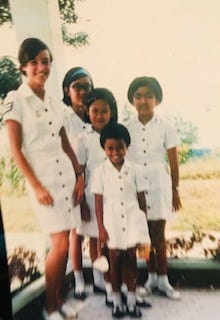
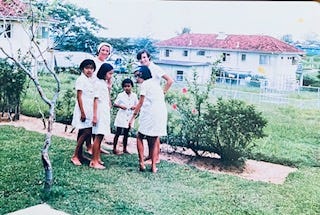
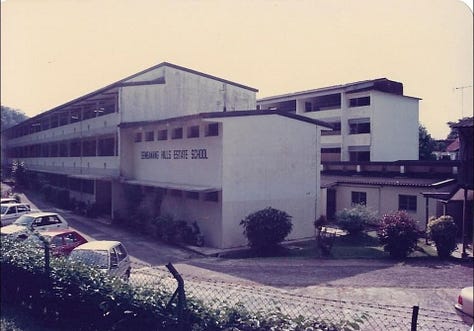
My class of 20 or so Malay, Indian & Chinese students were a delight. I taught first aid and English. It was a privilege to be chosen to lead the school in the Singapore National Day parade on the Pandang. The weather was hot and humid and we had to stand in the sun for many hours. I was the only western person marching, leading my class dressed in our starched white Red Cross uniforms. The challenge for me was to remember the marching instructions in Mandarin or was it Cantonese? I would have been embarrassed if I got it wrong. I felt proud to be part of this historic event, celebrating Singapore’s anniversary of independence. We marched past the Padang, where President Yusof Ishak and other dignitaries were seated, an unforgettable experience for me, one that made me appreciate Singapore more than ever.
In November after the Aden emergency escalated, Dad boarded ship, HMS Albion and went on active service in Aden (his second posting. He was part of the advance party n 1961) to cover the withdrawal from Aden after the NFL and FLOSY began fighting each other for control of Aden.
It was a tense time at home not knowing what was happening. We found out that over 3500 British personnel were evacuated. 45 commando was the last major unit to withdraw from the garrison with 42 Commando holding the line between Khormakser and Sheikh Othman. Dad told me there were contradictions, whilst some locals displayed anti-British sentiment and were firing at the last withdrawing British troops others were crying and shouting “no” as they feared how life would be as a republic.
One cold (by Singapore standards) grey morning at 4am we were driven in a landrover to the naval base to find the ship docked and Dad waving from the deck. Life returned to normal.
Christmas came and went. We ate our usual cooked Christmas meal joined by some naval personnel from a ship that was docked in the naval base. Our Christmas tree looked a bit scraggly compared to one we would have in England. I was over the moon with my main present, a portable turntable. The first album I bought was Procol Harem. Our only radio program was once a week on a Sunday evening by the British Broadcasting Service when we heard the top 10 from England. Motown was popular as was The Beach Boys, Wilson Pickett, Bee Gees, Creedence, Marvin Gaye, Bob Dylan, Fleetwood Mac and so many more.( I am a bit of a tragic fan of 60’s music with a long playing list on Spotify.)
Thanks so much for lasting this long. Do subscribe and read the next instalment of my adventures in Singapore. Next edition, dances, boyfriends, more food and further insight into life as a service brat.
Please do leave a comment so I know you are enjoying these memories.
.














